From a design standpoint, every garden needs two things: structure and a focal point. Without these, a space lacks coherence and interest, losing the opportunity for personality and becoming just a collection of plants through which we are left to wander. Many gardeners employ stone, steel or glass sculpture to provide that structural spine and to function as a focal point, directing the eye peacefully and purposefully through the space. Plants themselves can function as garden art, either by standing on their own or by intermingling with sculpted art to strengthen the impact of both. Let’s look at some options and how to put them to work in your garden.
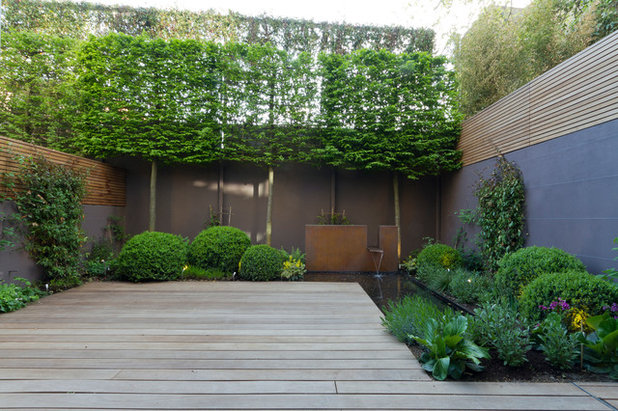
Landform Consultants Ltd
TreesWhen we think of plants and structure, trees immediately spring to mind. Very straight and narrow trees, such as this installation of European hornbeam (
Carpinus betulus ‘Fastigiata’, USDA zones 4 to 8; find your zone), ‘Slender Silhouette’ sweetgum (
Liquidambar styraciflua ‘Slender Silhouette’, zones 5 to 10) and ‘Tokyo Tower’ Chinese fringe tree (
Chionanthus retusus ‘Tokyo Tower’, zones 6 to 9) can add height to a garden. These are particularly effective when used in small courtyards that adjoin taller structures, as they reinforce the lines and scale of the architecture.
Narrow Trees for Tight Garden Spaces
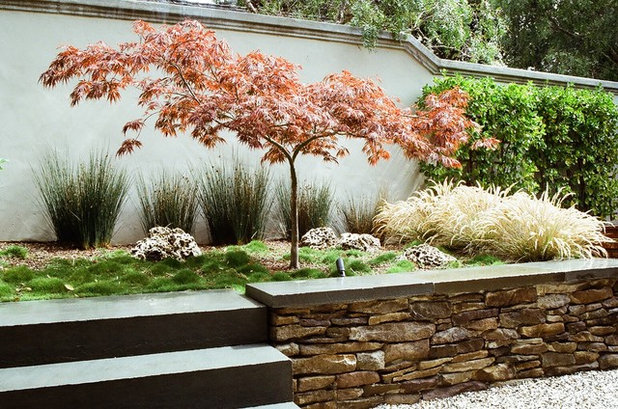
Robert Shuler Design
Japanese maples. Japanese maples (
Acer palmatum, zones 5 to 8) are prime candidates for artistic and structural use in the garden, because they tend to have such a strong form. Each tree is unique in its shape; some are narrow and upright, some are low and spreading, and some are weeping. Because each tree has its own shape, I find it necessary to hand-pick a tree that lends itself to the particular style of a space.
When choosing a Japanese maple, research on the front end will limit future disappointment. Some Japanese maples attain a height of 25 feet or more, while others remain under 10 feet.
See 11 Japanese maples with breathtaking color and form
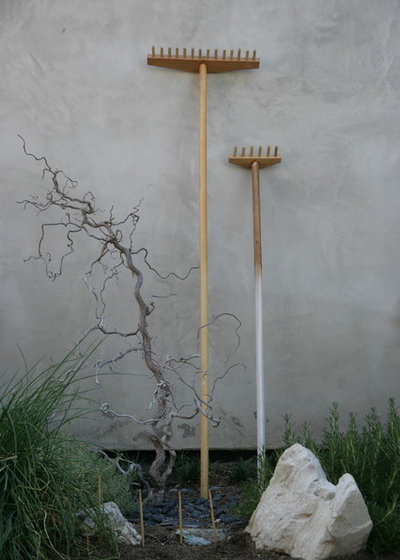
Lenkin Design Inc: Landscape and Garden Design
Contorted trees. Contorted trees, such as this Harry Lauder’s walking stick (
Corylus Avellana ‘Contorta’, zones 3 to 9), are favored for their strong sculptural form. Here, one is paired with Japanese wooden rakes for a simple and profoundly peaceful vignette.
I often tell my clients that contorted trees have raised arthritis to an art form.
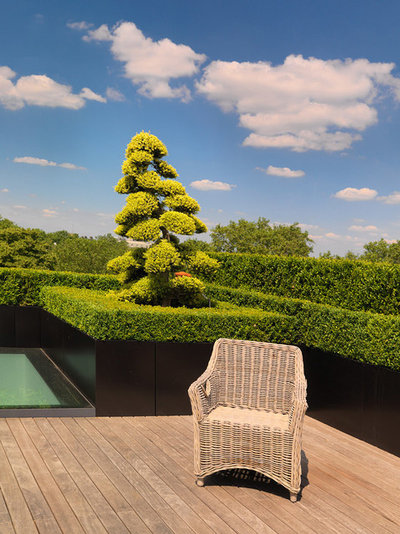
TLA Studio
Conifers. Conifers, such as this cloud-pruned specimen, have been used in Asian gardens for hundreds of years. Their strong form and the fact that they tolerate artistic pruning make them a go-to tree for living sculpture.
For highly stylized trees, such as the one shown here, it is better to display a single specimen or, in a larger space, separate them so that only one is seen from any particular vantage point.

Lee's Oriental Landscape Art
Many conifers, left unpruned, sport unique characteristics that raise them to the level of living sculpture.
Here, a weeping blue atlas cedar (
Cedrus atlantica ‘Glauca Pendula’, zones 7 to 9) presides over a garden composed primarily of dark green foliage. The contrast in foliage colors is subtle and sublime, lending a peaceful air to this space. The cedar’s shape brings to mind an apparition, a dinosaur or perhaps a blue heron on the lookout for lunch.
As with the Japanese maples, I recommend hand-picking specimens because shapes vary widely. Look for a tree that conjures up mental images that appropriately tell your garden’s story. Doing so will allow your garden to linger in the minds of its visitors long after they depart.

Jay Sifford Garden Design
Plants can be paired with boulders, architectural elements and sculptures to create high-powered vignettes that are greater than the sum of their parts.
Here, a blue atlas cedar is wrapped around a granite parking lot car stop set on end to create an unexpected vignette. Either would be interesting on its own, but the marriage makes for a one-of-a-kind focal point. Turn your imagination loose to find just the right combination that tells your story.

eDEN Garden Rooms
Pollarded trees. Pollarding is a centuries-old technique that originated in Europe. It involves pruning a tree (originally to above livestock grazing height) when it is dormant so that it produces multiple new growths once the tree breaks dormancy. Correctly performed, pollarding keeps a tree within a manageable and predetermined scale.
Here we see a sculptural allée of pollarded trees thoughtfully installed in a very contemporary space.
The following trees are good candidates for pollarding: beeches (
Fagus spp., zones 4 to 8, depending on species), black locust (
Robinia pseudoacacia, zones 3 to 9), lindens and limes (
Tilia spp., zones 3 to 8, depending on species), and planes
(Platanus spp., zones 4 to 9, depending on species).
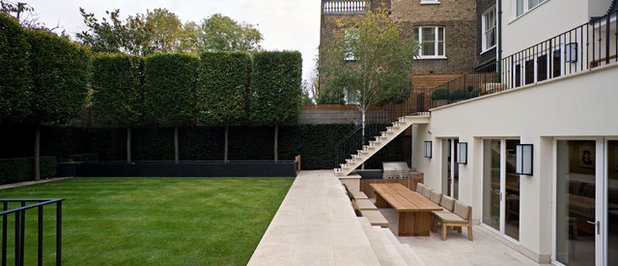
Hill Mitchell Berry Architects
Pleached trees. Like pollarding, pleaching is a centuries-old European technique. You can think of pleached trees as a raised hedge, as shown here. They generally connect but can also be pruned into rectangular shapes for more sculptural interest. Pleached trees are becoming popular in geometric contemporary gardens.
Hornbeams are often seen in a pleached form, and many trees that are recommended for pollarding may also be pleached.
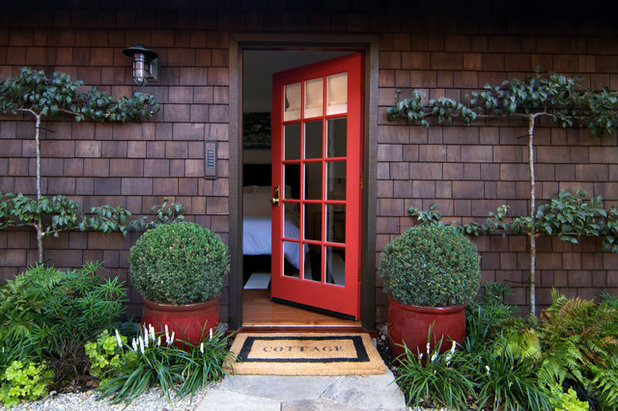
Boxleaf Design, Inc.
Espaliered trees. Like pollarding and pleaching, espalier is an old technique that originated in Europe. Espalier involves growing small trees in a two-dimensional form, usually against a fence or a wall. This maximizes space in a smaller garden and, when trees are placed against stone or brick walls, creates microclimates by keeping the plants warmer.
Espaliered trees can perform reliably as wall sculpture. Used in multiples, they produce rhythm in the garden, as shown here.
Fruit trees, such as apple and pear, are most frequently used for espalier, although espaliered conifers are sometimes available. Annual maintenance is needed for these trees to retain their desired shapes.
Learn more about the art of the espalier
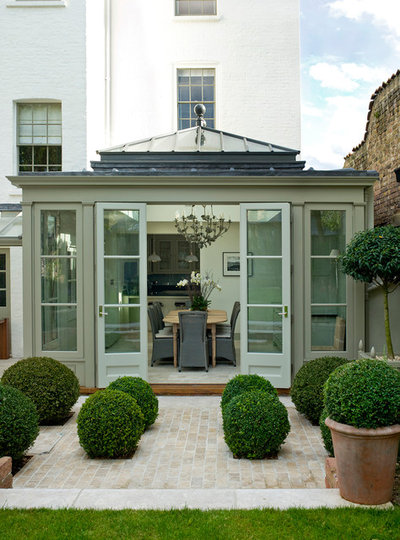
Sims Hilditch
ShrubsShrubs, either with a natural sculptural form or pruned into various shapes, are obvious choices when sculptural plants are needed in the garden.
Boxwood (
Buxus spp., zones 4 to 8) plants are often seen in both traditional and contemporary gardens, because of their naturally rounded shape. In traditional gardens they may function as foundation plants or as edging along a path. Boxwood meets the challenges of more contemporary gardens when planted in a grid pattern or when placed on a hardscaped terrace, as shown here. In fact, placing a plant on a terrace or wide walkway gives it an element of surprise and sets it off as a sculptural piece.
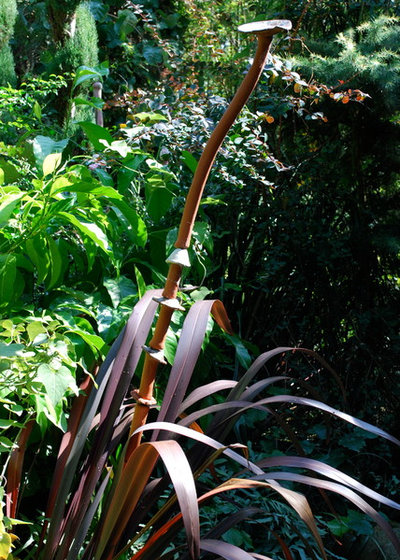
Jay Sifford Garden Design
PerennialsMany perennials, plants that die down in the winter and reemerge in the spring, have sculptural characteristics. Look for perennials that have a natural vase-shaped, globose or very vertical form.
This photo shows New Zealand flax (
Phormium sp., zones 8 to 11) effectively paired with a sculpture in the Berkeley, California, garden of artist Marcia Donahue. The vignette works well because the flax picks up the shape and hue of the sculpture, but because the flax leaves curl downward, the plant actually lends its organic form to the art. This is another example of the impact of the vignette’s being more than the sum of its parts.
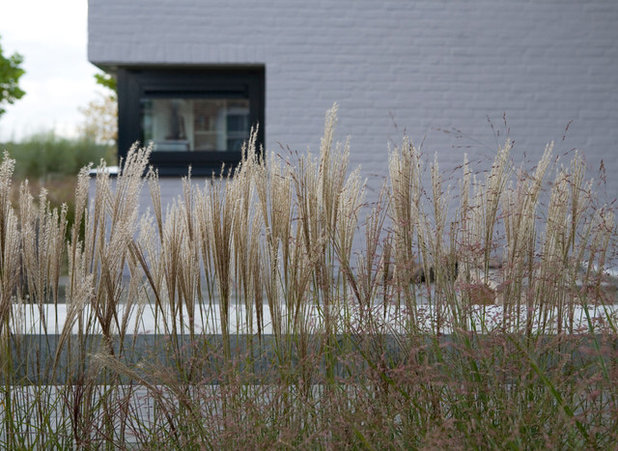
Studio TOOP
Ornamental grasses, most of which are technically perennials, bring a sculptural presence to a space when they are planted thoughtfully. The strong verticality of grasses such as ‘Northwind’ switchgrass (
Panicum virgatum ‘Northwind’, zones 2 to 9) and ‘Karl Foerster’ feather reed grass (
Calamagrostis x acutiflora ‘Karl Foerster’, zones 5 to 9) plays well with the wispy seed heads, creating an interesting study in form and texture.
Ornamental grasses work well in contemporary gardens when planted in blocks, in grids or in parallel lines amid hardscape. Additionally, they can be worked into more traditional beds of flowering perennials for contrast and year-round interest.
See how to grow more ornamental grasses
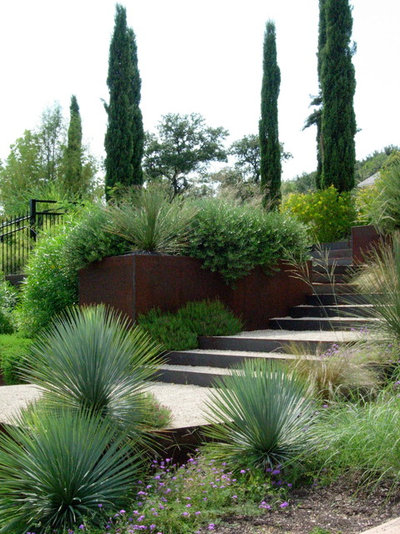
D-CRAIN Design and Construction
Succulents and CactusesDrought-tolerant plants such as succulents and cactuses are increasingly earning their place in our landscapes. Many succulents, such as these yuccas (
Yucca sp., zones 4 to 10, depending on type), have a strong sculptural form that elevates them to the status of garden art. In this photo, they are paired with very sculptural Italian cypresses (
Cupressus sempervirens,
zones 7 to 10) to create an art installation filled with juxtaposition and interest.
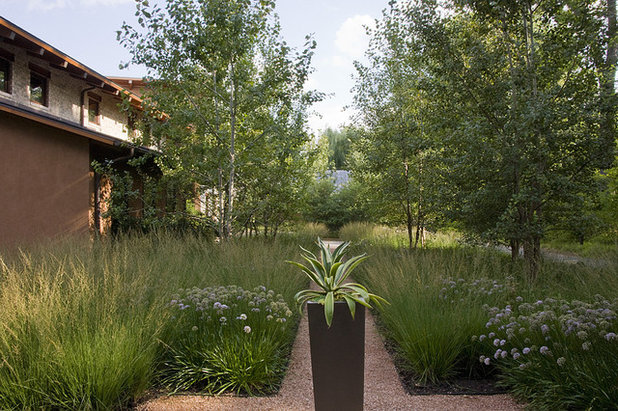
The Garden Consultants, Inc.
Succulents, despite their strong sculptural form, do not automatically fit every garden style. If you have a traditional, formal or prairie-style garden, consider planting succulents in a large container. The container will function as the transition between styles. This works because containers work equally well in arid, traditional and contemporary gardens. Additionally, containers frame and elevate sculptural plants in a way that draws attention to their form.
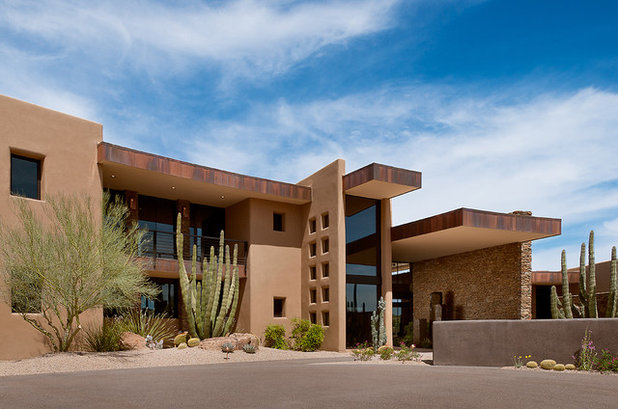
Tate Studio Architects
Cactuses, such as this organ pipe cactus (
Stenocereus thurberi,
zones 9 to 11), are unexcelled as sculptural plants in the arid regions where they grow. This specimen breaks up the continuum of low plantings in its recessed bed by providing height that both speaks to and grounds this home. Additionally, its verticality mimics the pattern found in the bands of metal cladding.





